Sourdough bread, known for its thick, chewy crust and soft, airy interior, is a classic example of traditional baking’s simple elegance. Made with just flour, salt, and water, sourdough has surged in popularity the last few years, attracting beginner and seasoned bakers alike! The key to its distinctive taste and texture lies in the sourdough starter, a fermented mixture that naturally leavens the bread. This guide simplifies the process of creating and maintaining your own starter, and it teaches you how to bake your own sourdough loaf.
If you love homemade bread, you absolutely need to try homemade French bread, cinnamon swirl bread, and this easy sandwich bread.
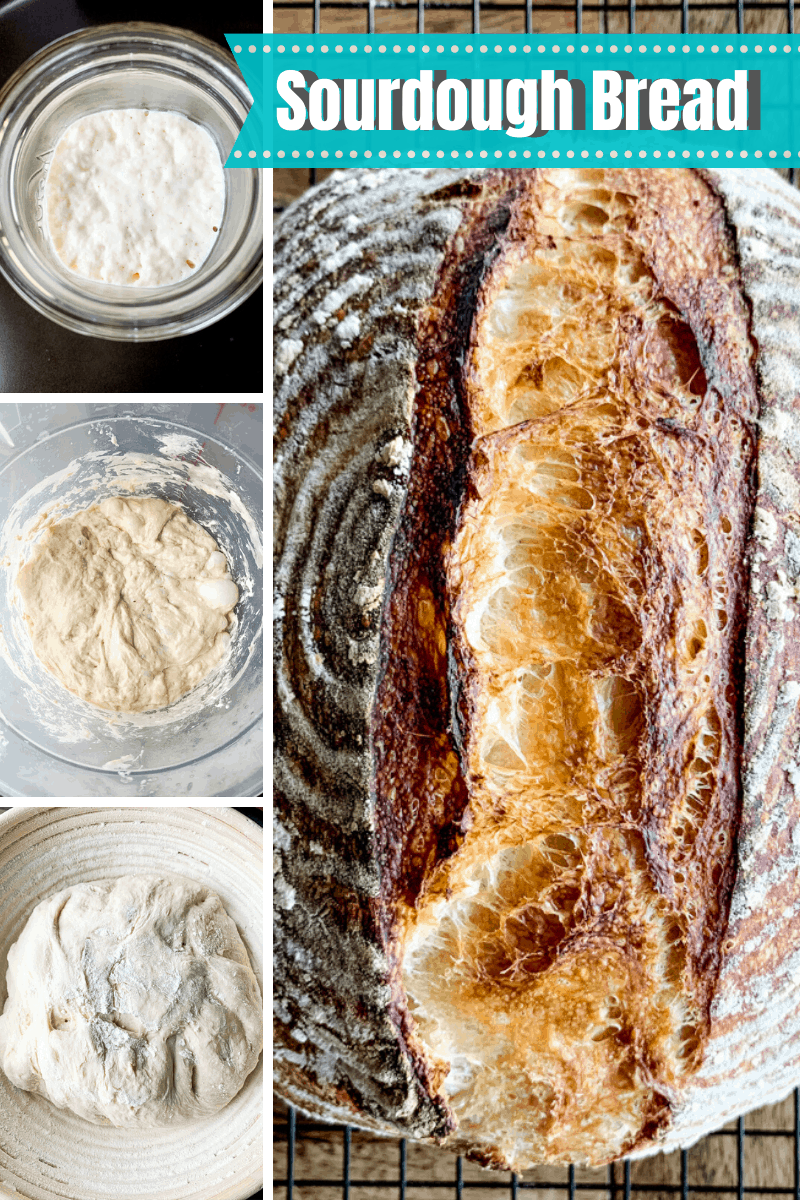
Sourdough Bread Recipe
We know many people are looking for an easy introduction to sourdough, without worrying about technique, so consider this your introductory lesson to making sourdough starter and bread from scratch. There are many methods and recipes for sourdough out there, and we are just focusing on one simple method. If you graduate from this and want to get fancy, there is a lot more to try out with sourdough baking!
The most important first step is to have a sourdough starter. You might already know someone with a starter, and if so, you’ve got an easy head start! You don’t need a lot, just get a couple of tablespoons and then immediately feed. If you aren’t lucky enough to have family or friends with an active sourdough starter, you can make your own from flour, water, and a bit of patience.
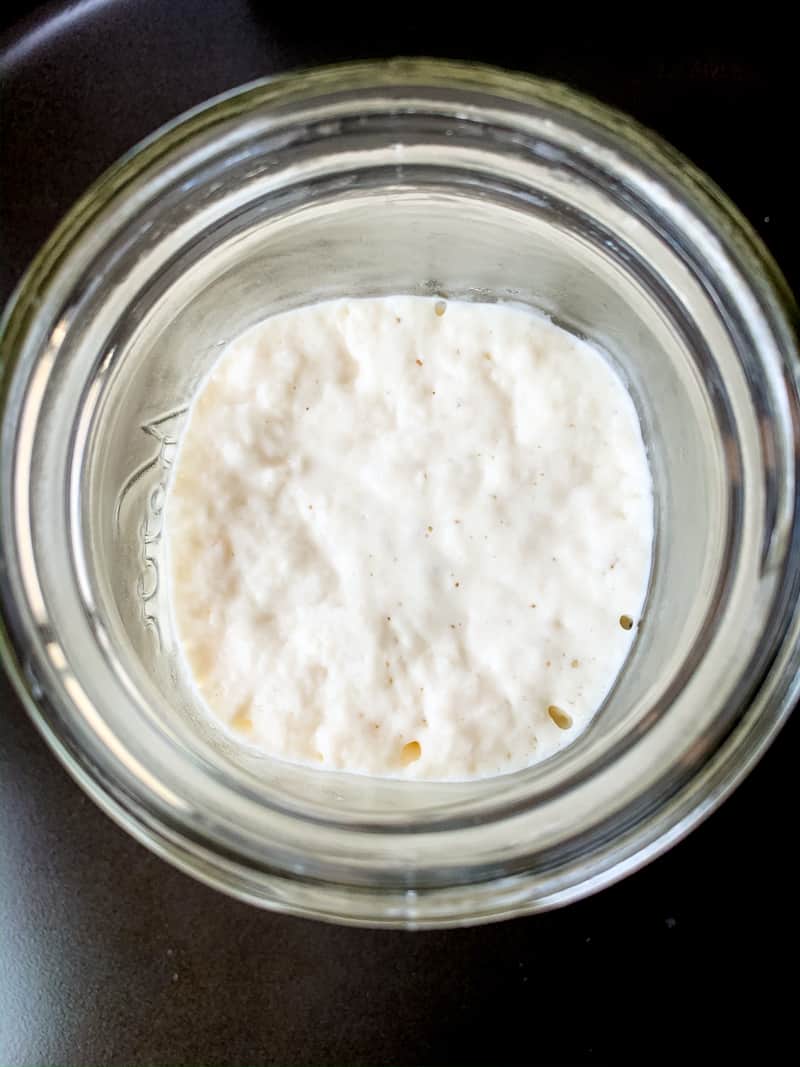
How to Make Your Own Sourdough Starter:
Wild yeast lives in the air and flour, it’s everywhere really! Breads made from wild yeast do not require commercial yeast. To make your own wild yeast sourdough starter
- Fill a larger plastic or glass container with 1/2 cup flour and 1/2 cup water. Stir until thoroughly combined into a smooth batter.
- Cover with a loosely screwed on lid or plastic wrap.
- “Feed” your starter 4 ounces of water and flour, stirring until combined, every 24 hours.
- Notice any air bubbles day to day, both large and small, that means it’s working and the wild yeasts are doubling! It should start to smell sour after a few days, but room temperature can affect how quickly it activates. Don’t worry too much about it, just keep feeding it every day. The texture will change from a pancake dough batter to an airy, lighter batter over the first 5 days.
- By day 5, or once it smells sour and is airy and doubling in volume, it is ready to use in your preferred sourdough bread recipe!
How to Maintain a Sourdough Starter
If you bake bread often, you can leave your starter on the counter and feed daily to keep it active. We like to feed 5 Tablespoons of both flour and water. You’ll find that your jar can’t contain that much starter, as it will double in size each time you feed it. You can either discard a bit of starter before each feed, or you can save it and use in waffles, pancakes, pizza dough, or even fry up that discarded starter in oil and add some seasonings as a delicious, sourdough ‘pancake!’ Just always make sure to leave at least 2 tablespoons of starter behind to continue to feed. You never want to use it all up.
If you want to only make bread once each week or less, keep your starter stored in the fridge. 2 days before you’re ready to make bread, remove it from the fridge and feed and leave on the counter. 24 hours later, feed it again. It could take anywhere from 2-5 hours for the starter to be fully active and ready to use after that second feed. Once it is fully active and doubled in size, you are ready to bake. Make sure to feed your starter after each discard or use.
Using Your Sourdough Starter: Making the Dough
Now that your starter has doubled in size and is billowing at the top, you are ready to make your bread dough. We like a larger loaf, so mix 5 cups of flour with 2 cups of water. Either all purpose or bread flour will work, though we prefer bread flour. You can start mixing with a wooden spoon if you like, but you’ll realize pretty quickly that a spoon will only get you so far, and you’ll want to switch to just mixing by hand. The dough will be really sticky and thick. Let the dough rest for 45 minutes with a lid on or covered in plastic wrap. This resting process where gluten development begins is called the autolyse.
First Rise
After 45 minutes, add in 1 Tablespoon salt and 1/2 cup of your starter to the water/flour mixture. Mix this all in by hand until well combined, but do not knead. Let it rise for anywhere from 12-24 hours. In the winter, when the house is cooler, we let this rise for about 20 hours. In the summer, we stick fairly close to 12-14 hours. You just want it to double in size. Without adding any commercial yeast, this can be a fairly long process, so we tend to do this first rise overnight.
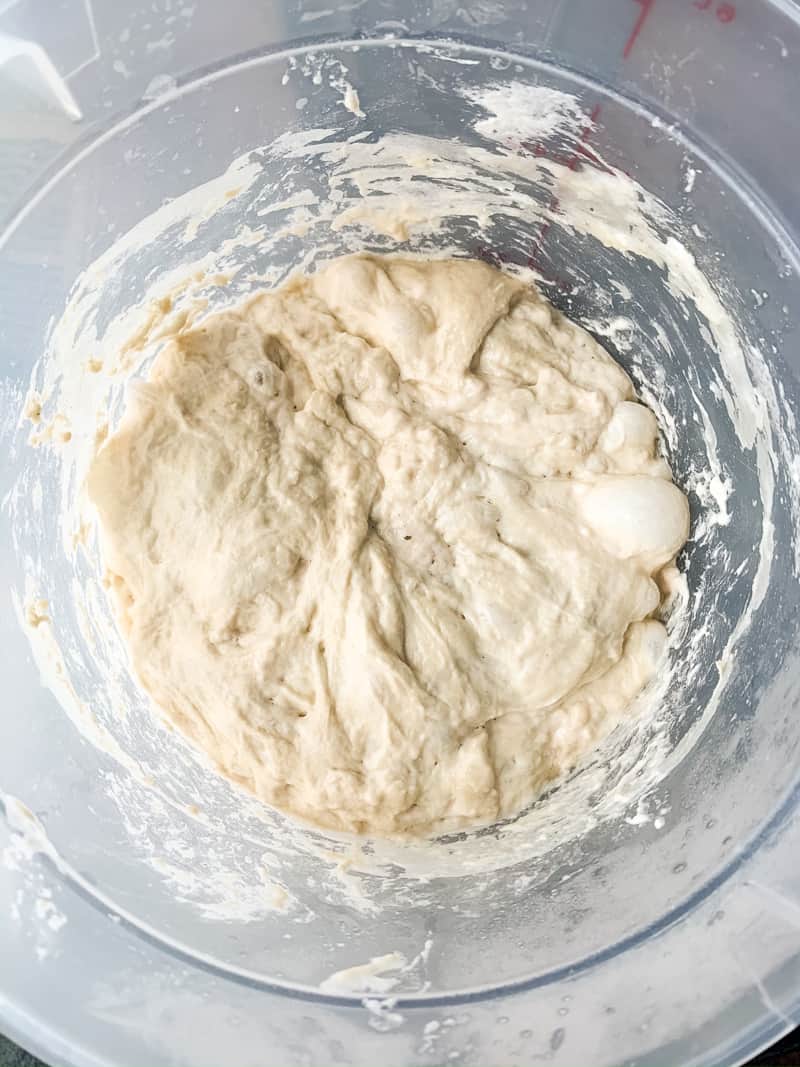
Second Rise
Once the dough has doubled in size, dump it out onto a clean, floured surface and fold it over a few times into the center. Transfer this to an oiled bowl or to a floured proofing basket. Let it rise for 3-5 hours. You’ll know it’s ready when you poke it with your finger (not too harshly) and the indent remains, or only very slowly springs back while still leaving an indent. If the dough springs right back, it needs more time to rise.
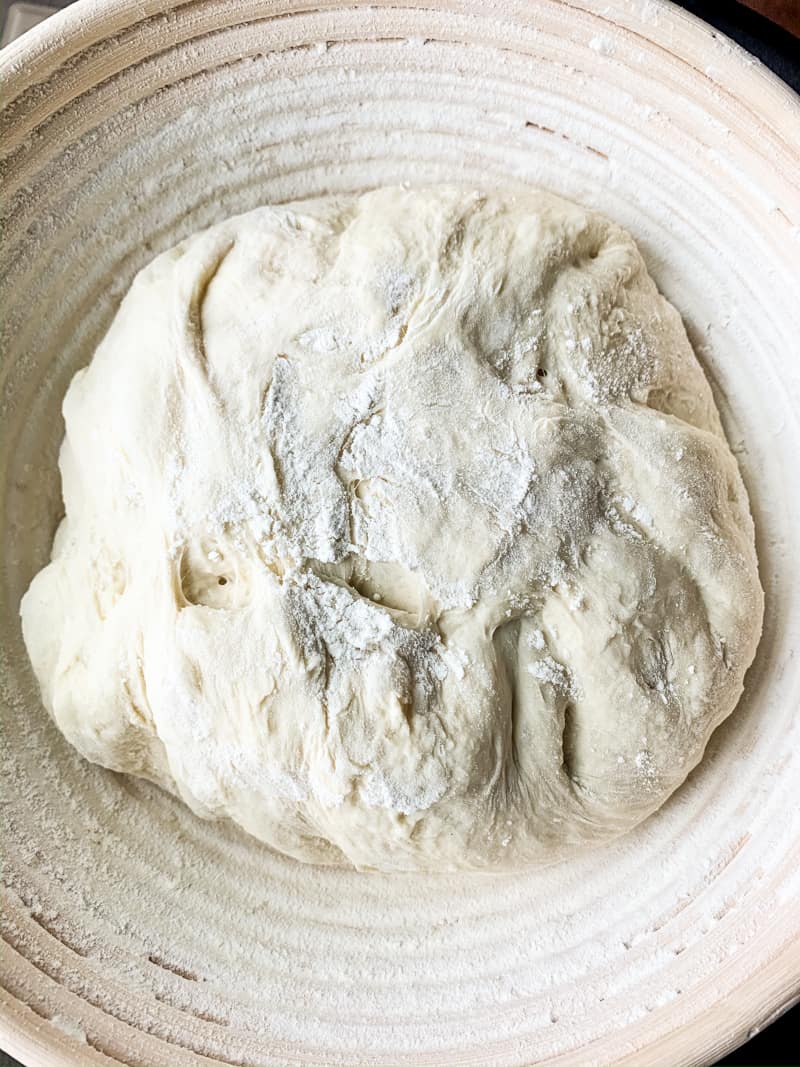
Baking Sourdough Bread
Once your dough is fully risen, preheat your oven to 450 degrees Fahrenheit with your dutch oven in the oven for the entire preheating time. Flip your dough from your basket/bowl onto a bread sling or large piece of parchment paper. Use that excess parchment paper to help lift the dough into the dutch oven. Put lid on and bake for 30 minutes. After 30 minutes, remove the lid and continue to bake until bread is a deep brown, approximately 30 more minutes.
PRO TIP: Put a baking sheet under your dutch oven when you remove the lid, and bake for the remaining time this way. This will ensure the bottom of the bread doesn’t get too dark or burn.
Once the bread is a deep brown, turn off oven and crack the door. Let your bread cool in the cracked oven for 20 minutes before removing from oven and dutch oven, and putting on a cooling rack. Cutting into a warm loaf of bread is SO tempting, but it is important to let the bread cool completely to allow texture and flavor to develop completely.
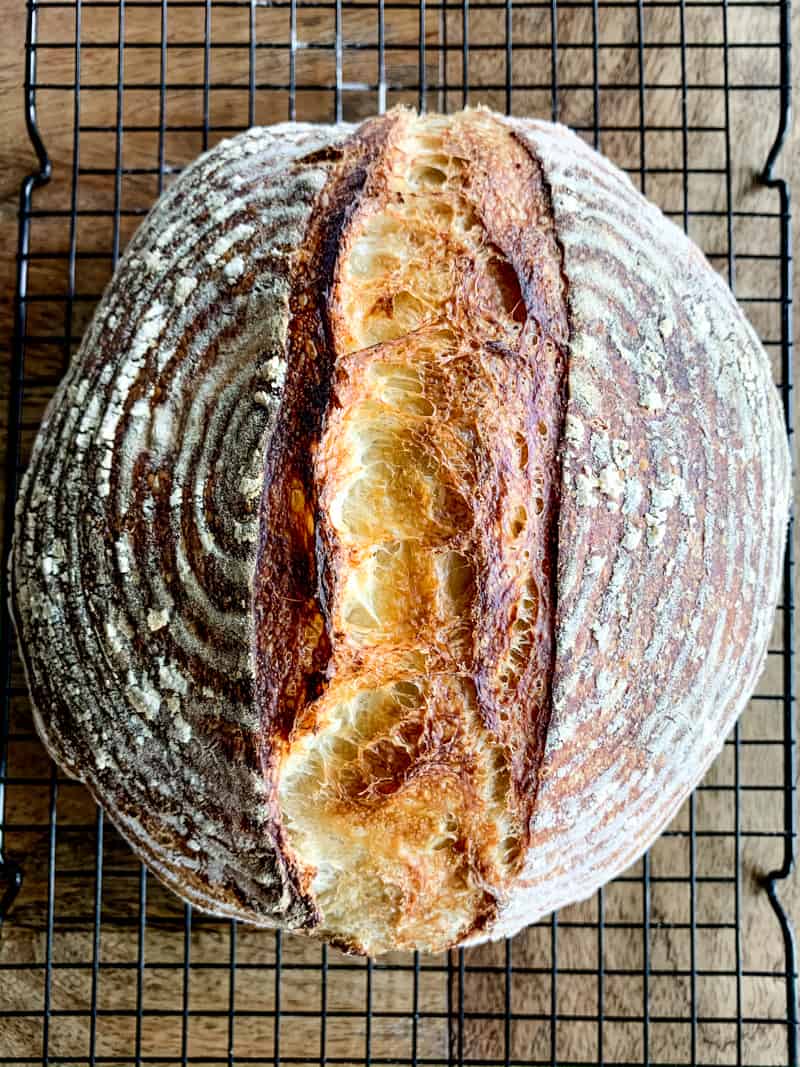
Storage Instructions for Sourdough Bread
Room Temperature Storage:
- Cool the bread completely before storing.
- Wrap the bread in a clean, dry cloth or place it in a paper bag to maintain its crust’s texture.
- Store in a cool, dry place for up to 3 days.
Refrigerator Storage:
- Not recommended, as it can dry out the bread and affect texture.
Freezer Instructions for Sourdough:
- Slice the bread if desired for easier use.
- Wrap slices or whole loaves tightly in plastic wrap or aluminum foil.
- Place wrapped bread in a freezer bag or airtight container.
- Label the bag or container with the date.
- Freeze for up to 3 months.
To Thaw:
- Leave at room temperature, wrapped, until thawed. For slices, you can toast directly from frozen for convenience.


Do you remove half of the starter when you add the firs 4oz of water and 4 oz of flour or only after that wilt additional feedings?
I generally do not start to discard until day 4-6: once it’s starting to smell sour or have some bubbles. At that point, you want to always discard half of the starter before feeding.
My no-knead sourdough bread loaf bakes into a lovely rounded loaf with store bought yeast, but will not rise as much when I substitute in my month-old starter. What do I need to do differently with the starter recipe?
My best bet is that the starter is not at its peak when you put it into the recipe. You want to wait until your starter has doubled in size since your last feed before you use it. If you wait too long after that point, it will start to deflate and will not work as well in your recipe.
So it’s day 4 , only a few small bubbles , hasn’t grown or started smelling sour. Now what? Start over…?
You’re on your way! If you are seeing bubbles already that is a great sign! The starter can take a couple of weeks before it is ready to use, so don’t give up now! You’ll notice a smell in the next day or two. You may even start to see some liquid on the top called hooch. All of those things are signs that the wild bacteria are multiplying. Continue on with the daily feeds. Once you notice a smell and/or hooch on top, start discarding half of your starter before each feed. Some people like to move on to twice/day feeds at that point too to help it move along even faster. You are doing great, and before you know it, your starter will be fully active and ready to go!
Hi. I have a 3.5 week old starter that started to double. I want to try your recipe to make my first sourdough bread. I feed my starter ever 12 hours. Do I feed right before doing your recipe or it doesn’t matter? Thanks
You want to wait to use your starter until approx 3-6 hours after a feed: when it has doubled and is at its peak.
Hello,
What do you cover the bowl with during the first rise? I’ve found that the top dries out a bit
when covering with a towel. What would you suggest?
Thank you
Yes, a towel is not the best for the first rise. I recommend either using a bowl (or bucket) with a lid that snaps on. If you don’t have access to one, plastic wrap will work too.
Just curious, but I am new to bread making! I am seeing a lot of recipes using far more than 1/2 cup of starter, and closer to 2 cups. Why do some recipes call for more or less starter? Also, this is the most straight forward started recipe I have found!
Ah, now we’re getting into the science of bread making and wild yeasts multiplying and such. However, it is commonly agreed amongst bread makers, professional and otherwise, that the least amount of starter + more time allowed to ferment = a better flavor and crumb.
It is necessary to bake bread in the Dutch oven ? Can I bake it in a baking sheet (with dusted parchment paper) and a water bowl on the bottom of the oven?
You can bake this in any oven safe pot or even a baking dish or cookie sheet, but you will want to cover the top with foil if you don’t have a pot + lid.
I don’t have dutch oven, and I don’t have a lid to cover that would be safe to bake with, can I use anything else to bake the bread? I can use foil to cover instead of lid?
Yes, in a pinch foil to cover would work. You really just need something oven safe and a covering. Any sort of oven safe pot will do.
Do you add extra flour to the top of the loaf for decoration? I see that some loaves have that while others do not
I don’t, but you definitely can. Rice flour is preferred if you are going to do that.
Love this recipe!! Can I add raisins and cinnamon to the bread dough?
You can! With any dried fruit in bread, you will need to soak them in water to rehydrate before adding to the dough. Also, cinnamon can slow fermentation, so don’t be surprised if you need to add an additional hour or so to the first rise time.